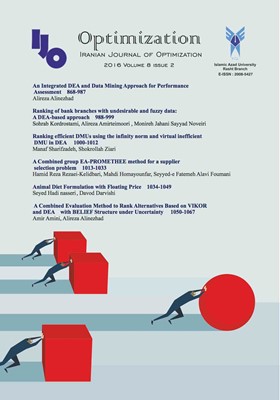An Integrated DEA and Data Mining Approach for Performance Assessment
Subject Areas : Data Envelopment Analysis
1 - Associate professor, Faculty of Industrial and Mechanical Engineering, Qazvin branch, Islamic Azad University, Qazvin, Iran.
Keywords: Data envelopment analysis, Malmquist Index, Productivity, Classification and regression tree, Bootstrapping,
Abstract :
This paper presents a data envelopment analysis (DEA) model combined with Bootstrapping to assess performance of one of the Data mining Algorithms. We applied a two-step process for performance productivity analysis of insurance branches within a case study. First, using a DEA model, the study analyzes the productivity of eighteen decision-making units (DMUs). Using a Malmquist index, DEA determines the productivity scores but cannot give details of factors depend on regress and progress productivity. The proposed model presents anew latent variable radial input-oriented technology and simultaneously reduces inputs and undesirable outputs in a single multiple objective linear programming. On the other hand, classification and regression tree allow DMU to extract rules for exploring and discovering meaningful and hidden information from the vast databases. The results provide a set of rules that can be used by policy makers to explore reasons behind the progress and regress produc-tivities of DMUs.
Barr, R., SeifordL, M., & Siems, T.F., Forecasting bank failure: a non-parametric approach. Recherches Economies de Louvain, 60,411-429.
Breiman, L., Friedman, J., Olshen, R., & Stone, C. Classification and Regression Trees, Pacific Grove, CA: Wadsworth-Monterey.
Bretholt, A., & Pan, J. (2013). Evolving the Latant Variable model as an environmental DEA technology. Omega ,
Caves, DW., Christensen, L.R., & Diewert WE. (1982). Multilateral comparisons of output input and productivity using index numbers. Economic Journal
Charnes, A., Cooper, W.W., & Rhodes, E. .Measuring the efficiency of decision-making units. European Journal of Operational Research,
Chen, Y. L., Hsu, C. L., & Chou, S. C. Constructing a multivalued and multi-labeled decision tree. Expert Systems with Applications 25(2),199-209.
Clark, L., & Pregibon, D. (1992). Tree based models, in J.M. Chambers and T.J. Hastie (eds), Statistical Models in S, Pacific Grove, CA: Wadsworth & Brooks/Cole Advanced Books & Software, 377-419.
Emrouznejad, A., & Anouze, A. (2010). Data envelopment analysis with classification and regression tree- a case of banking efficiency. Expert System the Journal of Knowledge Engineering,
Emrouznejad, A., Parker, B., & Tavares, G. (2008) Evaluation of research in efficacy and productivity: a survey and analysis of the first years of scholarly literature in DEA. Socio-Economic Planning Sciences, .
Fare, R., & Grosskopf, S. (2008). A Comment on Weak Disposability in Nonparametric Productivity Analysis with Undesirable Outputs. American Journal of Agricultural Economics.
Fare, R., Grosskopf S., Lovell CAK. Production frontiers. Cambridge: Cambridge University Press.
Han, J., & Kamber M. Data Mining Concepts and Techniques, San Francisco, CA: Morgan Kaufmann.
Hand, D.J., Mannila, H., & Smyth, P. Principles of Data, Cambridge, MA: MIT Press.
Koopmans, T. (1951). Activity analysis of production and allocation. New York: John Wiley & Sons;
Lee, J. H., & Park, S. C. (2005). Intelligent profitable customer’s segmentation system based on business intelligence tools. Expert Systems with Applications,29(1),145-152.
Malmquist, S. (1953). Index numbers and indifference surfaces. Trabajos de Estatis- tica;
Pareto, V. (1909). Manuel d’ Economie Politique. Paris: Giars & Briere;
Pille, P., & Paradi, J. (1997). Facets at the frontier and efficiency measurement in DEA,Paper presented at the Fifth European Workshop on Efficiency andProductivity Analysis, Copenhagen, October.
Samoilenko, S., Osei-Bryson, K.M., Using Data Envelopment Analysis (DEA) for monitoring efficiency-based performance of productivity-driven organizations: Design and implementation of a decision support system, Omega ,
Seol, H., Choi J., Park G., & Park, Y. (2007). A framework for benchmarking service process using data envelopment analysis and decision tree. Expert System with Application,
Sohn, S.Y., & Moon, T.H. (200). Decision tree based on data envelopment analysis for effective technology commercialization, Expert Systems with Applications,24,279-284.
Zhu, J. (2004). Quantitative models for performance evaluation and benchmarking. Boston: Kluwer Academic Publishers.

